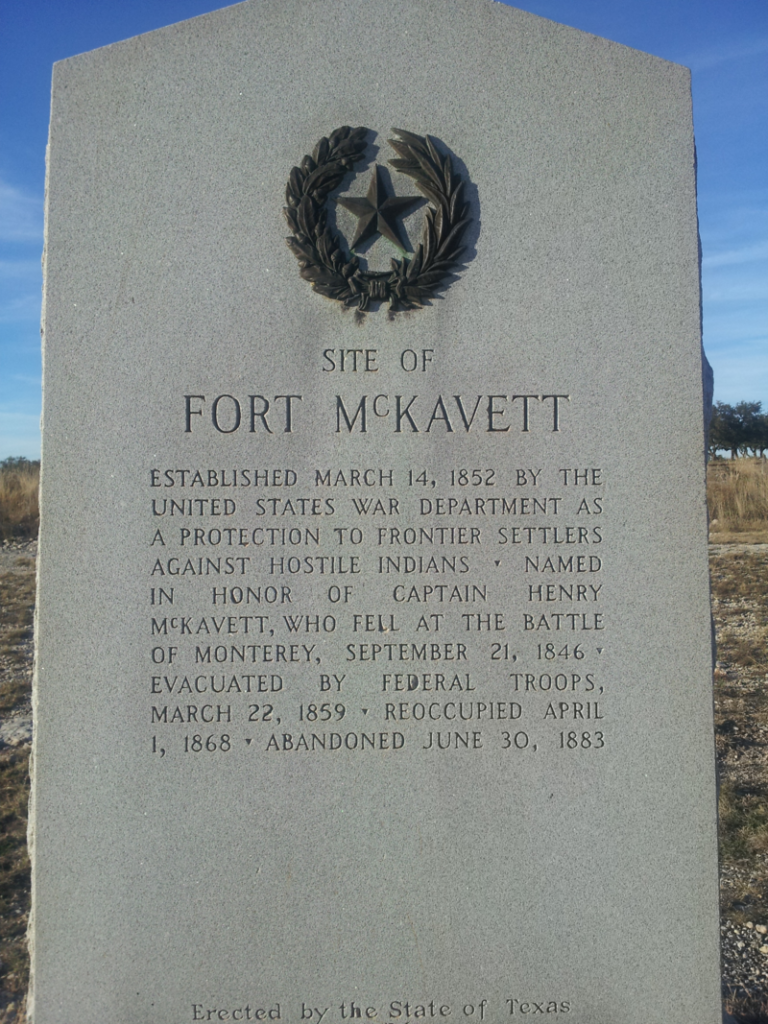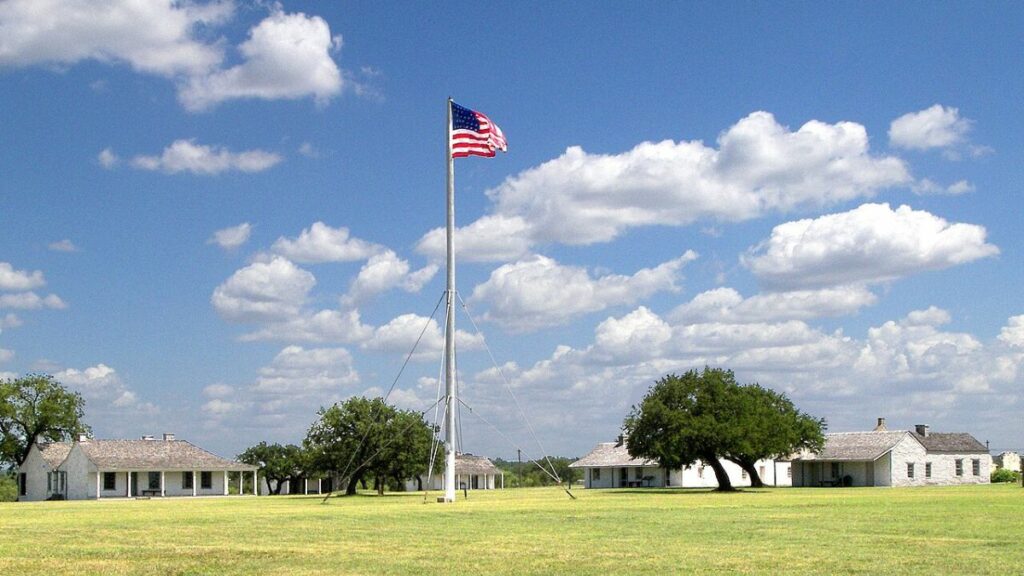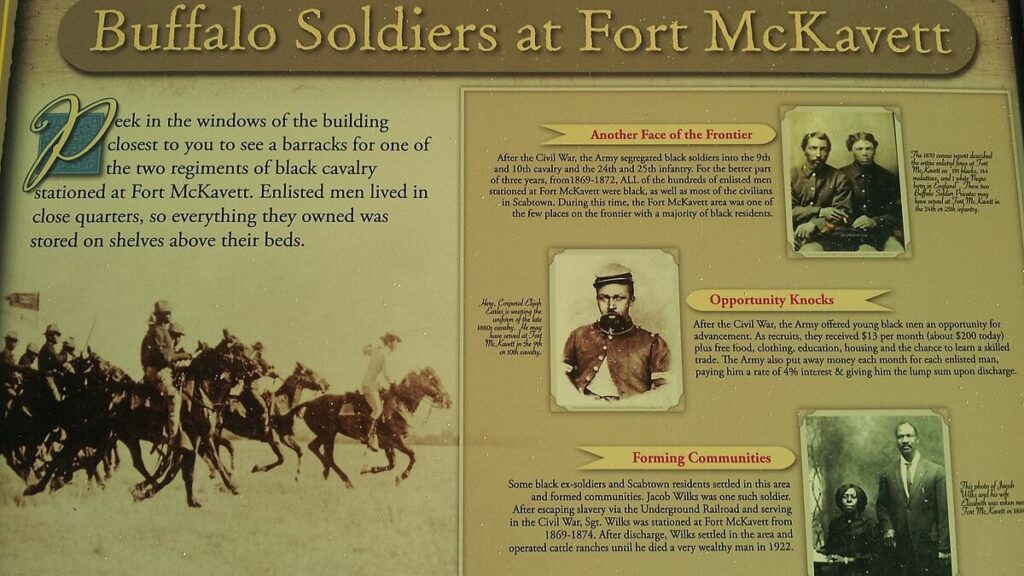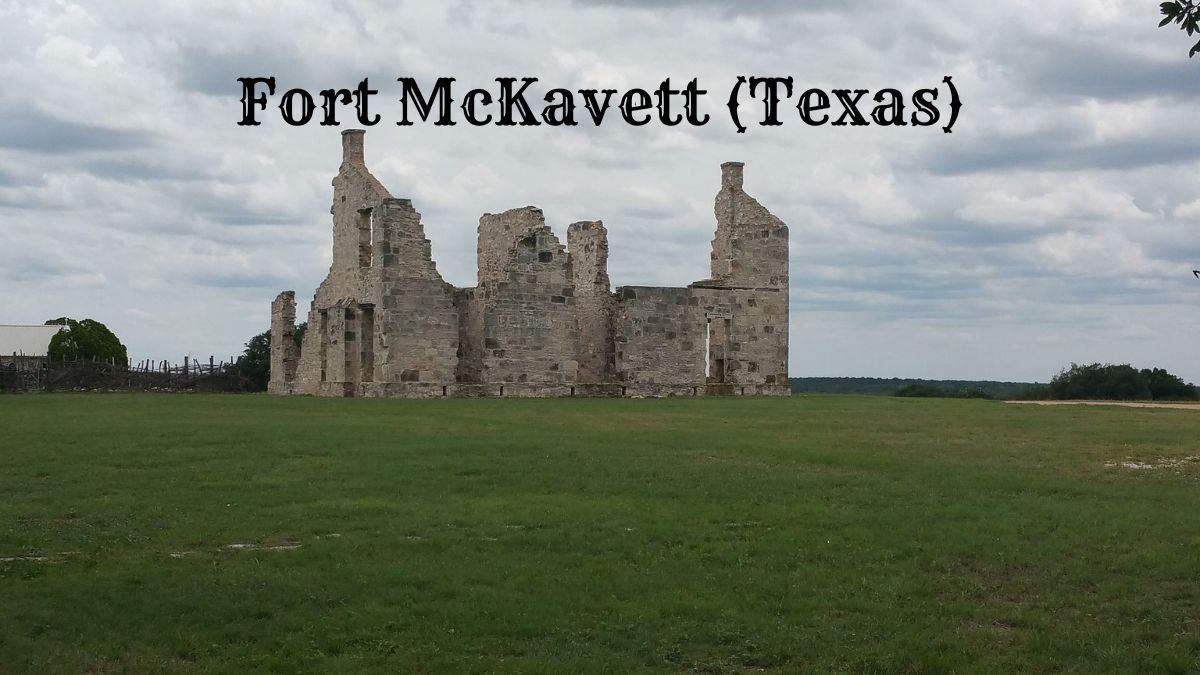Fort McKavett offers a fascinating glimpse into U.S. military history in the heart of Texas.
Established in 1852, this historic landmark was pivotal in protecting settlers from Native American tribes and was a strategic post during the Civil War.
Home to the renowned Buffalo Soldiers, Fort McKavett witnessed numerous patrols and skirmishes, significantly contributing to the westward expansion.
Although its military importance waned by the late 1870s, the fort’s legacy endures through meticulously preserved structures and engaging exhibits, providing visitors with a rich narrative of bravery, resilience, and history.
History of Fort McKavett

Fort McKavett, located in Texas, played a crucial role in the U.S. military history, particularly during the Civil War and afterward.
It was home to Buffalo Soldiers and saw significant use before its decline and abandonment.
Establishment and Military Significance
Fort McKavett was established in March 1852. Its purpose was to protect settlers moving through the region against Comanche and other Native American tribes.
The fort’s strategic location on the San Saba River helped safeguard important travel routes and communication lines.
The fort initially housed infantry and mounted riflemen. It served as a defensive post and contributed to the expansion of western territories.
Its importance as a military post is underscored by its recurrent use and its role in regional security.
Role During the Civil War
During the Civil War, Union forces abandoned Fort McKavett in 1861. Confederate forces occupied it briefly but did not utilize it extensively.
The region saw minimal direct conflict, leading to the fort’s neglect during the war.
Post-war, the fort was reoccupied by the United States Army in 1868. This reestablishment aimed to renew efforts to protect settlers and maintain order in the area.
Its role during this period helped reintegrate the area under federal control and secure the western frontier.
Buffalo Soldiers and African American Troops
After the Civil War, Fort McKavett became notable for housing Buffalo Soldiers. These African American troops had a significant role in maintaining peace and security in the region.
The 24th and 25th Infantry Regiments, composed of African American soldiers, were stationed at the fort.
Their presence marked a critical chapter in the fort’s history.
The Buffalo Soldiers conducted numerous patrols and skirmishes against Native American tribes, contributing to the westward expansion and protection efforts.
Their service at Fort McKavett is a proud legacy of bravery and dedication.
Decline and Abandonment
By the late 1870s, the Indian threat had diminished significantly. This, coupled with the expansion of the railway system, reduced the fort’s strategic significance.
The military gradually reduced its presence, and Fort McKavett saw a decline in activity.
The United States Army officially abandoned the fort in 1883. Buildings fell into disrepair, and the site became less populated.
Today, Fort McKavett State Historic Site preserves the fort’s remains, offering a glimpse into its storied past and significance in Texas history.
Preservation and Historical Site

Fort McKavett’s historic site is cherished for its rich heritage and meticulously managed preservation efforts. The site functions as both a museum and a vibrant part of the community, drawing numerous visitors annually.
Restoration Efforts
The Texas Historical Commission spearheads the restoration efforts at Fort McKavett State Historic Site.
Comprehensive projects focus on stabilizing the original structures, repairing stone walls, and conserving key ruins.
Volunteers and historians work together, ensuring the careful retention of the site’s authenticity.
Modern techniques monitor and mitigate deterioration, balancing preservation and accessibility.
Museum and Education
The Fort McKavett Museum, located within the historic buildings, offers extensive exhibits highlighting the site’s military and cultural history.
Artifacts, uniforms, and interactive displays educate visitors on 19th-century frontier life.
Educational programs, including guided tours and historical reenactments, are tailored for schools and history enthusiasts. They provide a hands-on learning experience about Texas’s military heritage.
Role in Community and Tourism
Fort McKavett plays a crucial role in the local community and tourism.
As a state historic site, it attracts history buffs, school groups, and families.
Events like living history demonstrations and community festivals enhance its allure as an attraction.
The site fosters a sense of pride and connection among residents, while tourism drives economic benefits, supporting local businesses and preservation initiatives.
Military Life at Fort McKavett

Fort McKavett, located in Menard County, Texas, was a hub of military activity during the Indian Wars. Soldiers’ daily lives, relationships with Native American tribes, and notable personalities defined the fort’s unique atmosphere.
Daily Activities and Infrastructure
Soldiers at Fort McKavett followed structured routines. Infantrymen and cavalrymen were regularly drilled in formations, weapons handling, and tactics.
The headquarters coordinated all activities, ensuring discipline and readiness.
The fort’s infrastructure included barracks for enlisted men, officers’ quarters, a hospital, and horse stables.
The soldiers maintained the fort’s defenses and performed other duties, such as patrolling the surrounding areas.
A large responsibility involved building and repairing roads and buildings. This was crucial for maintaining operational efficiency.
The availability of fresh water and supply lines also heavily influenced daily life.
Relations with Native American Tribes
Fort McKavett’s relations with Native American tribes were complex. The soldiers often encountered the Comanche and other tribes during various campaigns.
The fort served as a base for the 4th Cavalry and 8th U.S. Infantry, who were instrumental in the Indian Wars.
While tensions were high, there were instances of negotiated peace and collaboration. The Handbook of Texas Online provides accounts of both conflict and temporary alliances.
Buffalo Soldiers, or African-American regiments such as the 24th and 41st Infantry, marked a significant period.
These units often engaged in skirmishes and efforts to protect settlers, showcasing their resilience and bravery.
Personalities and Key Figures
Several notable figures shaped Fort McKavett’s history.
Colonel Ranald Mackenzie, a prominent commander, was influential in leading campaigns against Native American tribes. His strategies and leadership left a lasting impact.
The fort also hosted other significant personalities, including officers from the 8th Infantry and the 4th Cavalry.
They played vital roles in combat and daily operations, contributing to the fort’s legacy.
The commanding officer held significant authority, managing everything from military engagements to logistical matters.
Reports from this period highlight the fort’s critical strategic importance and the key figures who were integral to its functioning.
Shaping West Texas Settlement and Culture
Fort McKavett’s location played a crucial role in the settlement of West Texas and had significant cultural impacts on local communities and educational institutions.
Strategic Location and Surrounding Area
Fort McKavett is situated in Hill Country, Texas, near Menard. This area, characterized by its picturesque vistas and rugged terrain, served as a defensive outpost for the Texas frontier.
The fort’s positioning was strategic, guarding settlers from Native American attacks and providing a base for military operations.
The surrounding region includes Government Springs, a vital water source for the fort and the local community.
Fort McKavett also supported other nearby military camps, such as Camp San Saba, enhancing its strategic importance.
Impact on Local Communities
The presence of Fort McKavett positively influenced the development of nearby settlements.
The fort attracted settlers to the West Texas frontier, establishing Scabtown and other small communities.
These settlers benefited from the protection and trade opportunities the fort provided.
Military personnel and their families became integral to the local social fabric.
The fort also fostered economic growth through increased demand for goods and services.
This interaction helped shape the region’s cultural landscape, blending military and civilian lives.
Reference in Literature and Education
Fort McKavett has left its mark on literature and educational studies.
Various historical texts and research papers examine the site, particularly its role on the Texas frontier.
The University of Texas at Austin houses several studies and artifacts related to the fort, providing valuable educational resources.
Fort McKavett State Historic Site offers educational programs and history tours that offer insights into the lives of soldiers and settlers.
These programs are essential for preserving the cultural heritage and educating future generations about the fort’s historical significance.
Explore More: Army Forts in Texas: Exploring Big Texas Military Bases
Architecture and Archaeology
Fort McKavett, Texas, features striking architectural elements and has yielded significant archaeological findings. The site offers insights into its inhabitants’ construction techniques and daily life.
Structural Features and Construction
Fort McKavett incorporates a variety of structures, many of which are built using local limestone.
The commanding officer’s quarters, officer’s quarters, and barracks are notable for their durable limestone walls, which provided insulation against the Texas heat.
The post-hospital was another vital structure designed to cater to the medical needs of soldiers. It had large, airy rooms and a robust water supply system using sinks and cisterns.
Additionally, the guardhouse had reinforced walls, ensuring security.
Ancillary buildings like the bakery and kitchens were constructed near the main quarters, facilitating military operations.
The post schoolhouse catered to educating soldiers’ children, reflecting a semblance of normalcy.
Archaeological Findings and Research
Archaeological digs at Fort McKavett unearthed various artifacts, providing a glimpse into daily military life and the fort’s operational history.
Items such as tools, pottery shards, and personal belongings reveal details about the daily routines of soldiers and residents.
Excavations around the lime kiln unearthed significant evidence of construction methods, displaying the fort’s self-sufficiency.
Researchers also examined the site known as the dead house, where medical and personal artifacts were found. These artifacts offer insight into health and mortality at the fort.
Findings around the schoolhouse and living quarters revealed toys and educational materials, hinting at the social life within the fort’s community.
Explore More: 10 Historic Forts in Texas
Fort McKavett’s Legacy
Fort McKavett is a significant historical site with a rich legacy tied to the frontier forts of Texas. This legacy includes various honors and is present in modern culture.
Historical Recognition and Honors
Fort McKavett holds a prestigious place among the frontier forts of Texas.
Established in 1852, it was crucial in military campaigns and scientific and mapping explorations.
The Texas Historical Commission now manages the site, preserving its history.
Important figures like General William T. Sherman and Captain Henry McKavett are associated with the fort, with Captain McKavett’s name being commemorated.
The fort’s significance is also noted in honors such as the Medal of Honor awarded to individuals stationed there.
It served as a key outpost for settlers and travelers navigating the western frontier, especially along the southerly route to the Rio Grande.
Fort McKavett’s laundress, schoolhouse, and parade ground remain integral parts of its historical narrative.
The Fort in Modern Culture
In modern culture, Fort McKavett is a symbol of the American frontier era. Several attractions, like reenactments and educational programs, bring its history to life for visitors.
It is frequently referenced in discussions about Texas’s military past and the network of frontier forts, including Fort Mason, Fort Chadbourne, and others.
The fort’s legacy is also depicted in various media, showcasing the struggles and daily life at the site. It provides a lens to view issues such as violence, racism, and interactions with Comanches.
Despite becoming nearly a ghost town after its military decommissioning, Fort McKavett remains a vital educational resource today.

Cory is a website owner and content creator who enjoys fishing, history, coin collecting, and sports, among other hobbies. He is a husband and father of four.
Romans 15:4 For whatever was written in former days was written for our instruction, that through endurance and through the encouragement of the Scriptures we might have hope.

